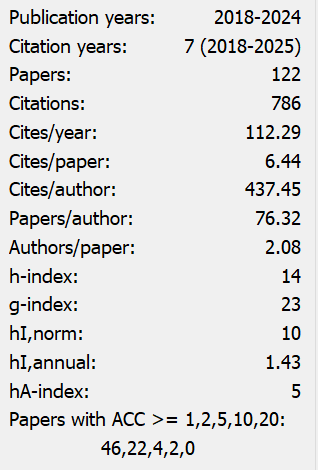The Impact of Financial Agglomeration on the Real Economy
Abstract
This paper investigates the impact of financial agglomeration on China's real economy, especially during the critical transition of the 14th Five-Year Plan period. Drawing on theories of economic growth and industrial agglomeration, it explores how financial concentration enhances resource allocation efficiency and generates scale and spillover effects. Using panel data from 2007 to 2024 and classifying finance into banking, insurance, and securities, the study finds that financial agglomeration—especially in banking—significantly promotes real economic development. Through static panel regression analysis, the results highlight the positive role of financial clustering in supporting high-quality economic growth, offering insights and policy recommendations for aligning financial development with the needs of the real economy.
References
[2] Al Mamun, M., Boubaker, S., & Nguyen, D. K. (2022). Green finance and decarbonization: Evidence from around the world. Finance Research Letters, 46, 102807. https://doi.org/10.1016/j.frl.2022.102807
[3] Buera, F., & Shin, Y. (2008). Financial frictions and the persistence of history: A quantitative exploration. University of California Mimeographed Document.
[4] Kindleberger, C. P. (1978). The formation of financial centers: Economic response comparative studies in trade, finance, and growth. Journal of Physics G: Nuclear and Particle Physics, 16, 1019–1037.
[5] Audress, D., & Feldman, M. (2006). Spillovers and the geography of innovation and production. American Economic Review, 86(3), 630–640.
[6] Kong, D., Xiong, M., & Qin, N. (2022). Business tax reform and CSR engagement: Evidence from China. International Review of Financial Analysis, 82, 102178. https://doi.org/10.1016/j.irfa.2022.102178
[7] Yang, Y., & Liu, W. (2024). Free trade agreements and domestic value added in exports: An analysis from the network perspective. Economic Modelling, 132, 106656. https://doi.org/10.1016/j.econmod.2024.106656
[8] Guan, M. N. (2019). Empirical study on financial agglomeration, innovation, and the growth of the real economy [Doctoral dissertation, Zhongnan University of Economics and Law]. Supervisor: Zhao, X. Q.
[9] Guo, X. X., & Zhang, Z. J. (2020). A study on the dynamic relationship between financial industry agglomeration and the development of the real economy—Based on a PVAR model of inter-provincial panel data. Western Finance, (01), 48–55.
[10] Dong, J. H. (2019). A study on the impact of financial agglomeration on China’s economic growth [Doctoral dissertation, Jilin University]. Supervisor: Du, J.
[11] Zhang, L., Sun, H., Pu, T., Sun, H., & Chen, Z. (2024). Do green finance and hi-tech innovation facilitate sustainable development? Evidence from the Yangtze River Economic Belt. Economic Analysis and Policy, 81, 1430–1442. https://doi.org/10.1016/j.eap.2024.02.005
[12] Yuan, H., et al. (2020). The spatial threshold effect and its regional boundary of financial agglomeration on green development: A case study in China. Journal of Cleaner Production, 244, 118670. https://doi.org/10.1016/j.jclepro.2019.118670
[13] Abegaz, M., & Nene, G. (2022). Export agglomeration economies in Sub-Saharan Africa manufacturing and service sectors. The Quarterly Review of Economics and Finance, 84, 40–51. https://doi.org/10.1016/j.qref.2022.01.005
[14] Qin, L., Chen, C., Chen, Y., & Su, Y. (2024). Digital financial inclusion, analyst attention, and the green innovation in energy firms. Finance Research Letters, 67, 105947. https://doi.org/10.1016/j.frl.2024.105947
[15] Zhang, C. S., & Zhang, B. T. (2016). The puzzle of the declining industrial investment rate in China: A perspective of economic financialization. Economic Research Journal, 51(12), 32–46.
[16] Wu, J. Y., & Teng, J. Z. (2020). A study on regional differences in the impact of economic financialization on the real economy—A spatial econometric analysis based on provincial panel data. Exploration of Economic Issues, (07), 15–27.
[17] Cull, R., Gan, L., Gao, N., & Xu, L. C. (2022). Social capital, finance, and consumption: Evidence from a representative sample of Chinese households. Journal of Banking & Finance, 145, 106637. https://doi.org/10.1016/j.jbankfin.2022.106637
[18] Ma, H., Yin, Y., Liu, Z., & Bai, Y. (2024). A study of the impact of digital finance usage on household consumption upgrading: Based on financial asset allocation perspective. International Review of Economics and Finance, 96, 103628. https://doi.org/10.1016/j.iref.2024.103628
[19] Wang, Y., & Li, L. (2024). Digital economy, industrial structure upgrading, and residents’ consumption: Empirical evidence from prefecture-level cities in China. International Review of Economics and Finance, 92, 1045–1058. https://doi.org/10.1016/j.iref.2024.02.069
[20] Zhang, S., & Zhou, Q. (2025). The impact of digital finance on farmers’ consumption decisions: An analysis based on the moderating effect of risk preference. International Review of Financial Analysis, 99, 103928. https://doi.org/10.1016/j.irfa.2025.103928
[21] Li, X. Y. (2019). A study on the efficiency of financial support for the development of the real economy in Anhui Province [Doctoral dissertation, Anhui University of Finance and Economics].
[22] Ma, Y., Jiang, Y. Q., & Fu, L. (2021). Economic openness, financial agglomeration, and the efficiency of financial support to the real economy. International Finance Research, (02), 3–11.

This work is licensed under a Creative Commons Attribution 4.0 International License.
Copyright for this article is retained by the author(s), with first publication rights granted to the journal.
This is an open-access article distributed under the terms and conditions of the Creative Commons Attribution license (http://creativecommons.org/licenses/by/4.0/).


























